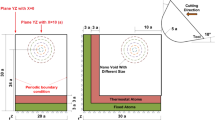Abstract
The nanodrilling process of copper substrates is studied using molecular dynamics simulations. The effects of the rotation velocity of the tool and substrate temperature are evaluated in terms of atomic trajectories, slip vector, thrust force, stress, flow field, and hole characteristics. The simulation shows that the main hole-making mechanism for drilling with low rotation velocities (0.1°/ps or lower) is mechanical indentation. The number of removed atoms and influence area of the substrate increase with increasing rotation velocity of the tool. When the rotation velocity of the tool or substrate temperature increases, the influence area expands more in the radial direction than in the axial direction. The required thrust force for making a hole is lower at a higher rotation velocity of the tool and higher substrate temperature. Undesirable elastic recovery after drilling can be reduced by increasing the rotation velocity of the tool.









Similar content being viewed by others
References
S.Y. Chou, P.R. Krauss, P.J. Renstrom, J. Vac. Sci. Technol., B 14(6), 4129 (1996)
Q. Xia, K.J. Morton, R.H. Austin, S.Y. Chou, Nano Lett. 8(11), 3830 (2008)
R.D. Piner, J. Zhu, F. Xu, S. Hong, C.A. Mirkin, Science 283, 61 (1999)
S. Matsui, T. Kaito, J.I. Fujita, M. Komuro, K. Kanda, Y. Haruyama, J. Vac. Sci. Technol., B 18, 3181 (2000)
Q.F. Xia, J.J.S. Yang, W. Wu, X.M. Li, R.S. Williams, Nano Lett. 10, 2909 (2010)
Q.C. Hsu, J.J. Hsiao, T.L. Ho, C.D. Wu, Microelectron. Eng. 91, 178 (2012)
M. Schvartzman, K. Nguyen, M. Palma, J. Abramson, J. Sable, J. Hone, M.P. Sheetz, S.J. Wind, J. Vac. Sci. Technol., B 27, 61 (2009)
Q.C. Hsu, Y.T. Lin, D.C. Chou, C.D. Wu, Curr. Nanosci. 8(3), 424 (2012)
Q.C. Hsu, C.L. Lin, C.D. Wu, T.H. Fang, J. Comput. Theor. Nanosci. 9, 662 (2012)
C.D. Wu, T.H. Fang, Y.J. Huang, F.T. Weng, J. Comput. Theor. Nanosci. 9, 1611 (2012)
C.D. Wu, T.H. Fang, J.F. Lin, J. Appl. Phys. 111(10), 103521 (2012)
P.H. Sung, C.D. Wu, T.H. Fang, C.I. Weng, Appl. Surf. Sci. 258(18), 7064 (2012)
P.H. Sung, C.D. Wu, T.H. Fang, J. Phys. D Appl. Phys. 45, 215303 (2012)
S.J. Sun, S.P. Ju, Y.C. Lo, J.S. Lin, J. Appl. Phys. 97, 94308 (2005)
K. Maekawa, A. Itoh, Wear 188, 155 (1995)
C.C. Hwang, J.G. Chang, G.J. Huang, S.H. Huang, J. Appl. Phys. 92, 5904 (2001)
H.Y. Lai, P.H. Huang, T.H. Fang, Appl. Phys. A 86, 497 (2007)
S.F. Miller, P.J. Blau, A.J. Shih, J. Mater. Eng. Perform. 14(5), 647 (2005)
B.P. Raju, M.K. Swamy, IJERA 2(6), 716 (2012)
S.F. Miller, J. Tao, A.J. Shih, Int. J. Mach. Tool. Man. 46, 1526 (2006)
T.H. Fang, C.I. Weng, Nanotechnology 11, 148 (2000)
Acknowledgments
This work was supported by the National Science Council of Taiwan under grants NSC 100-2628-E-151-003-MY3 and NSC 100-2221-E-151-018-MY3.
Author information
Authors and Affiliations
Corresponding author
Rights and permissions
About this article
Cite this article
Wu, CD., Fang, TH. & Kuo, CH. Atomistic simulation of nanodrilling mechanics and mechanism on Cu substrates. Appl. Phys. A 118, 307–313 (2015). https://doi.org/10.1007/s00339-014-8732-5
Received:
Accepted:
Published:
Issue Date:
DOI: https://doi.org/10.1007/s00339-014-8732-5



